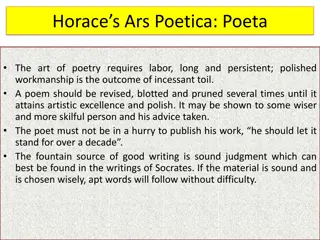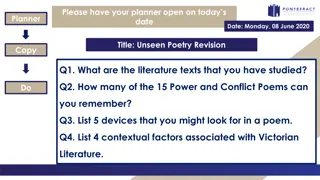Understanding and Enjoying Poetry: A Comprehensive Guide
Delve into the world of poetry with this comprehensive guide that explores the differences between prose and poetry, various types of poetry like cinquain and diamante poems, and the essence of haiku. Learn how to interpret and appreciate poetic verse through detailed explanations and examples. Unravel the beauty of poetic language and structure to enhance your poetic understanding and enjoyment.
Download Presentation

Please find below an Image/Link to download the presentation.
The content on the website is provided AS IS for your information and personal use only. It may not be sold, licensed, or shared on other websites without obtaining consent from the author. Download presentation by click this link. If you encounter any issues during the download, it is possible that the publisher has removed the file from their server.
E N D
Presentation Transcript
How to Interpret Poetry Learn to Understand and Enjoy Poetic Verse Benha University Faculty of Arts Department of English Language & Literature Second Semester 2020 Introduction to Poetry First Grade Mohammad Al-Hussini Mansour Abuarab Class 2 Types of Poetry
WHAT IS THE DIFFERENCE BETWEEN PROSE AND POETRY?
WHAT IS PROSE? Prose is writing or speaking that is done in an ordinary form using sentences and paragraphs.
WHAT IS POETRY? The word Poetry comes from the ancient Greek word - poieo - which means I create. Poetry is written in lines or stanzas which may or may not contain complete sentences. Poetry is usually shorter than prose. Words and lines in poetry have more rhythm than prose and there is sometimes rhyme in poetry.
CINQUAIN A five line poem containing 22 syllables How frail Above the bulk Of crashing water hangs Autumnal, evanescent, wan The moon. Two Syllables Four Syllables Six Syllables Eight Syllables Two Syllables
DIAMANTE POEMS Line 1: one word (subject/noun that is contrasting to line 7) Line 2: two words (adjectives) that describe line 1 Line 3: three words (action verbs) that relate to line 1 Line 4: four words (nouns) first 2 words relate to line 1; last 2 words relate to line 7 Line 5: three words (action verbs) that relate to line 7 Line 6: two words (adjectives) that describe line 7 Line 7: one word (subject/noun that is contrasting to line 1)
DIAMANTE POEMS Example: square symmetrical, conventional shaping, measuring, balancing boxes, rooms, clocks, halos encircling, circumnavigating, enclosing round, continuous circle
HAIKU A Haiku is a 3-line, unrhymed nature poem of 17 syllables, divide so that the first and third lines have 5 syllables each and the middle line has 7 syllables. Haiku poetry originated in Japan. An essential element of Haiku is that a season - or something that indicates a specific season - must be mentioned.
HAIKU A Haiku is a 3-line, unrhymed nature poem of 17 syllables, divide so that the first and third lines have 5 syllables each and the middle line has 7 syllables. Haiku poetry originated in Japan. An essential element of Haiku is that a season - or something that indicates a specific season - must be mentioned.
TANKA The Tanka poem is very similar to haiku but Tanka poems have more syllables and it uses simile, metaphor and personification. It consists of 5 lines for a total of 31 syllables. The syllables per line are according to the pattern: 5 -7 -5 - 7 - 7
CONCRETE POEMS Poetry In concrete poems, the words are arranged to create a picture that relates to the content of the poem. Is like Flames, Which are Swift and elusive Dodging realization Sparks, like words on the Paper, leap and dance in the Flickering firelight. The fiery Tongues, formless and shifting Shapes, tease the imiagination. Yet for those who see, Through their mind s Eye, they burn Up the page.
LIMERICK A limerick is a 5-line jingle whose purpose is humor. It usually has an aabba rhyme scheme. With the first, second, and fifth lines either anapestic or amphibrach trimeter, and the third and fourth lines of anapestic dimeter. There once was a lady from Niger Who smiled as she rode on the tiger. They returned from the ride With the lady inside, And the smile on the face of the tiger!
FREE VERSE Free verse is just what it says it is - poetry that is written without proper rules about form, rhyme, rhythm, meter, etc. Free verse poetry is very conversational - sounds like someone talking with you. A more modern type of poetry.
BLANK VERSE Written in lines of iambic pentameter, but does NOT use end rhyme. Example: Cowards die many times before their deaths; The valiant never taste of death but once. Of all the wonders that I yet have heard, It seems to me most strange that men should fear; Seeing that death, a necessary end, Will come when it will come. from Julius Caesar
NARRATIVE POETRY A poem that tells a story. Examples of Narrative Poems: Generally longer than the lyric styles of poetry b/c the poet needs to establish characters and a plot. The Raven The Highwayman Casey at the Bat The Walrus and the Carpenter
EPIC An epic is a book-length narrative poem about a single hero or group of people. Examples: Homer s Iliad is a epic about the Trogan War Longfellow s Evangeline ia another example of an epic
LYRIC POETRY Lyric poetry is one of the broad divisions of poetry. They are based on the personal thoughts and feelings of the author. They have a musical quality to them. They include a wide variety of patterns including sonnets, odes, and elegies. Example: "Dreams" "Dream Deferred" by Langston Hughes
SHAKESPEAREAN SONNET A fourteen line poem with a specific rhyme scheme. Shall I compare thee to a summer s day? Thou art more lovely and more temperate. Rough winds do shake the darling buds of May, The poem is written in three quatrains and ends with a couplet. And summer s lease hath all too short a date. Sometimes too hot the eye of heaven shines, And often is his gold complexion dimmed; And every fair from fair sometimes declines, The rhyme scheme is abab cdcd By chance or nature s changing course untrimmed. efef gg But thy eternal summer shall not fade Nor lose possession of that fair thou ow st; Nor shall Death brag thou wanderest in his shade, When in eternal lines to time thou grow st So long as men can breathe or eyes can see, So long lives this, and this gives life to thee.
SONNETS Sonnets use 14 lines to develop a theme. Each set of 4 lines is called a quatrain and the last pair is a couplet. The 1st quatrain states the theme The 2nd quatrain develops the theme The 3rd quatrain develops the theme or expresses conflict The couplet unifies the whole and provides the climax.
SONNETS Examples: Shakespeare s Sonnet XVIII-"Shall I compare thee to a summer's day? or Elizabeth Barret Browning's Sonnet XLIII- How do I love thee? Let me count the ways
BALLADS A ballads is a type of lyric poem that tells a story about a famous person or event. Originally ballads were written to be sung, like song lyrics. Ballads usually feature a refrain, which is a repeated phrase or idea. In most cases, ballads contain a specific rhyme pattern (abab or aabb), but may also be arranged in free verse form.
BALLADS Famous ballads include: Henry Wadsworth Longfellow s The Wreck of Hesperus and his Paul Revere s Ride.
ELEGY An elegy is a poem of mourning that is written in memory of someone. The mood of an elegy is usually somber. It may have any rhyme scheme, rhythm pattern, or stanza pattern. Example: "O Captain! My Captain!" by Walt Whitman, written for President Abraham Lincoln.
ODE An ode is a lengthy lyrical poem of praise. An ode may have any rhyme scheme, rhythm pattern, or stanza pattern. Examples: Ode to Duty by William Wordsworth To a Skylark by Percy Bysshe Shelley
PARODY Parody poetry is based on a poem that is well known that mimic of its rhythm, rhyme scheme, or phraseology is immediately recognized. The topic may be totally different from the original poem or it may have a different view or slant on the same topic. Example: Twas the night before Christmas and all through the flat, Not a creature was stirring, not even a rat.























